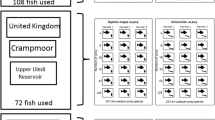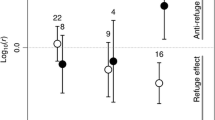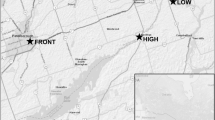Abstract
Biodiversity continues to decline at a range of spatial scales and there is an urgent requirement to understand how multiple drivers interact in causing such declines. Further, we require methodologies that can facilitate predictions of the effects of such drivers in the future. Habitat degradation and biological invasions are two of the most important threats to biodiversity and here we investigate their combined effects, both in terms of understanding and predicting impacts on native species. The predatory largemouth bass Micropterus salmoides is one of the World’s Worst Invaders, causing declines in native prey species, and its introduction often coincides with habitat simplification. We investigated the predatory functional response, as a measure of ecological impact, of juvenile largemouth bass in artificial vegetation over a range of habitat complexities (high, intermediate, low and zero). Prey, the female guppy Poecilia reticulata, were representative of native fish. As habitats became less complex, significantly more prey were consumed, since, even although attack rates declined, reduced handling times resulted in higher maximum feeding rates by bass. At all levels of habitat complexity, bass exhibited potentially population de-stabilising Type II functional responses, with no emergence of more stabilising Type III functional responses as often occurs in predator-prey relationships in complex habitats. Thus, habitat degradation and simplification potentially exacerbate the impact of this invasive species, but even highly complex habitats may ultimately not protect native species. The utilisation of functional responses under varying environmental contexts provides a method for the understanding and prediction of invasive species impacts.



Similar content being viewed by others
References
Akre BG, Johnson DM (1979) Switching and sigmoid functional response curves by damselfly naiads with alternative prey available. J Anim Ecol 48:703–720. doi:10.2307/4191
Alexander ME, Dick JTA, O’Connor NE et al (2012) Functional responses of the intertidal amphipod Echinogammarus marinus: effects of prey supply, model selection and habitat complexity. Mar Ecol Prog Ser 468:191–202. doi:10.3354/meps09978
Alexander ME, Dick JTA, O’Connor NE (2013) Trait-mediated indirect interactions in a marine intertidal system as quantified by functional responses. Oikos 122:1521–1531. doi:10.1111/j.1600-0706.2013.00472.x
Alexander ME, Dick JTA, Weyl OLF et al (2014) Existing and emerging high impact invasive species are characterized by higher functional responses than natives. Biol Lett 10:2–6
Almany GR (2004a) Does increased habitat complexity reduce predation and competition in coral reef fish assemblages? Oikos 106:275–284
Almany GR (2004b) Differential effects of habitat complexity, predators and competitors on abundance of juvenile and adult coral reef fishes. Oecologia 141:105–13. doi:10.1007/s00442-004-1617-0
Almeida D, Almodóvar A, Nicola GG et al (2012) Trophic plasticity of invasive juvenile largemouth bass Micropterus salmoides in Iberian streams. Fish Res 113:153–158. doi:10.1016/j.fishres.2011.11.002
Anderson TW (2001) Predator responses, prey refuges, and density-dependent mortality of a marine fish. Ecology 82:245–257. doi:10.2307/2680100
Beukers JS, Jones GP (1997) Habitat complexity modifies the impact of piscivores on a coral reef fish population. Oecologia 114:50–59. doi:10.1007/s004420050419
Bolker BM (2008) emdbook: Ecological models and data in R, R Package. Princeton University Press, Princeton, USA
Bollache L, Dick JTA, Farnsworth KD, Montgomery WI (2008) Comparison of the functional responses of invasive and native amphipods. Biol Lett 4:166–169. doi:10.1098/rsbl.2007.0554
Boström C, Mattila J, Christo JM (1999) The relative importance of food and shelter for seagrass-associated invertebrates: a latitudinal comparison of habitat choice by isopod grazers. Oecologia 120:162–170. doi:10.1007/s004420050845
Buckel JA, Stoner AW (2000) Functional response and switching behavior of young-of-the-year piscivorous bluefish. J Exp Mar Bio Ecol 245:25–41
Buisson L, Grenouillet G, Villéger S et al (2013) Toward a loss of functional diversity in stream fish assemblages under climate change. Glob Chang Biol 19:387–400. doi:10.1111/gcb.12056
Bunn SE, Arthington AH (2002) Basic principles and ecological consequences of altered flow regimes for aquatic biodiversity. Environ Manage 30:492–507. doi:10.1007/s00267-002-2737-0
Byers JE, Reichard S, Randall JM et al (2002) Directing research to reduce the impacts of nonindigenous species. Conserv Biol 16:630–640. doi:10.1046/j.1523-1739.2002.01057.x
Caldow RWG, Furness RW (2001) Does Holling’s disc equation explain the functional response of a kelptoparasite? J Anim Ecol 70:650–662
Coull BC, Wells JBJ (1983) Refuges from fish predation : experiments with phytal meiofauna from the New Zealand rocky intertidal. Ecology 64:1599–1609
Crawley MJ (2007) The R Book. John Wiley, Chichester
Crooks JA (1998) Habitat alteration and community-level effects of an exotic mussel, Musculista senhousia. Mar Ecol Prog Ser 162:137–152. doi:10.3354/meps162137
Crowder LB, Cooper WE (1982) Habitat structural complexity and the interaction between bluegills and their prey. Ecology 63:1802–1813
Dick JTA, Gallagher K, Avlijas S et al (2013) Ecological impacts of an invasive predator explained and predicted by comparative functional responses. Biol Invasions 15:837–845
Dick JTA, Alexander ME, Jeschke JM et al (2014) Advancing impact prediction and hypothesis testing in invasion ecology using a comparative functional response approach. Biol Invasions 16: 735–753
Didham RK, Tylianakis JM, Gemmell NJ et al (2007) Interactive effects of habitat modification and species invasion on native species decline. Trends Ecol Evol 22:489–96. doi:10.1016/j.tree.2007.07.001
Dudgeon D, Arthington AH, Gessner MO et al (2006) Freshwater biodiversity: importance, threats, status and conservation challenges. Biol Rev 81:163–182. doi:10.1017/S1464793105006950
Eggleston DB (1990) Behavioural mechanisms underlying variable functional responses of blue crabs, Callinectes sapidus, feding on juvenile oysters, Crassostrea virginica. J Anim Ecol 59:615–630. doi:10.2307/4884
Ellender BR, Weyl OLF, Swartz ER (2011) Invasion of a headwater stream by non-native fishes in the Swartkops river system, South Africa. Afr Zool 46:39–46
Elliott JM (2004) Prey switching in four species of carnivorous stoneflies. Freshw Biol 49:709–720. doi:10.1111/j.1365-2427.2004.01222.x
Facon B, Genton BJ, Shykoff J et al (2006) A general eco-evolutionary framework for understanding bioinvasions. Trends Ecol Evol 21:130–135. doi:10.1016/j.tree.2005.10.012
Fazey I, Fischer J, Lindenmayer DB (2005) What do conservation biologists publish? Biol Conserv 124:63–73. doi:10.1016/j.biocon.2005.01.013
Flynn AJ, Ritz DA (1999) Effect of habitat complexity and predatory style on the capture success of fish feeding on aggregated prey. J Mar Biol Assoc United Kingdom 79:487–494
Forrester GE, Steele MA (2004) Predators, prey refuges and the spatial scaling of density-dependent prey mortality. Ecology 85:1332–1342
Godinho FN, Ferreira MT (2000) Composition of endemic fish assemblages in relation to exotic species and river regulation in a temperate stream. Biol Invasions 2:231–244
Gosnell JS, DiPrima JB, Gaines SD (2012) Habitat complexity impacts persistence and species interactions in an intertidal whelk. Mar Biol 159:2867–2874. doi:10.1007/s00227-012-2047-x
Gotceitas V, Colgan P (1989) Predator foraging success and habitat complexity: quantitative test of the threshold hypothesis. Oecologia 80:158–166
Griffen BD, Delaney DG (2007) Species invasion shifts the importance of predator dependence. Ecology 88:3012–3021
Hassell MP (1978) Functional responses. In: Hassell M (ed) Dyn. Arthropod Predator-Prey Syst. Princeton University Press, Princeton, pp 28–49
Hassell MP, May RM (1973) Stability in insect Host-parasite models. J Anim Ecol 42:693–726
Heck KL, Crowder LB (1991) Habitat structure and predator-prey interactions in vegetated aquatic systems. In: Bell S, McCoy E, Mushinsky H (eds) Habitat struct. physcial arrange. objects Sp. Chapman and Hall, London, pp 281–299
Holling C (1959) Some characteristics of simple types of predation and parasitism. Can Entomol 91:385–398
Hothorn T, Bretz F, Westfall P (2008) Simultaneous inference in general parametric models. Biometrical J 50:346–363
Impson ND, Bills IR, Cambray JA (2002) A conservation plan for the unique and highly threatened freshwater fishes of the Cape Floral Kingdom. In: Collares-Pereira MJ, Coelho MM, Cowx I (eds) Conserv. Freshw. Fishes Options Futur. Blackwell Science, Oxford, pp 432–440
Jeschke JM, Hohberg K (2008) Predicting and testing functional responses: an example from a tardigrade–nematode system. Basic Appl Ecol 9:145–151. doi:10.1016/j.baae.2007.01.006
Jeschke JM, Kopp M, Tollrian R (2002) Predator functional responseas: discriminating between handling and digesting prey. Ecol Monogr 72:95–112. doi:10.2307/3100087
Jones CLW (2003) Intercohort cannibalism and parturition-associated behaviour of captive-bred swordtail, Xiphophorus helleri (Pisces: Poeciliidae), PhD thesis, Rhodes University, Grahamstown, 215 pp.
Juliano SA (2001) Nonlinear curve fitting: predation and functional response curves. In: Scheiner SM, Gurevitch J (eds) Des. anal. ecol. exp, 2nd ed. Oxford University Press, Oxford, pp 178–196
Koski ML, Johnson BM (2002) Functional response of kokanee salmon (Oncorhynchus nerka) to Daphnia at different light levels. Can J Fish Aquat Sci 59:707–716
Kushner RB, Hovel KA (2006) Effects of native predators and eelgrass habitat structure on the introduced Asian mussel Musculista senhousia (Benson in Cantor) in southern California. J Exp Mar Bio Ecol 332:166–177
Levine JM, D’Antonio CM (2003) Forecasting biological invasions with increasing international trade. Conserv Biol 17:322–326. doi:10.1046/j.1523-1739.2003.02038.x
Lipcius RN, Hines AH (1986) Variable functional responses of a marine predator in dissimilar homogeneous microhabitats. Ecology 67:1361–1371
MacNeil C, Dick JTA, Alexande ME et al (2013) Predators vs. alien: differential biotic resistance to an invasive species by two resident predators. NeoBiota 19:1–19. doi:10.3897/neobiota
Manatunge J, Asaeda T, Priyadarshana T (2000) The influence of structural complexity on fish-zooplankton interactions: a study using artificial submerged macrophytes. Environ Biol Fishes 58:425–438
Mokany K, Harwood TD, Williams KJ, Ferrier S (2012) Dynamic macroecology and the future for biodiversity. Glob Chang Biol 18:3149–3159. doi:10.1111/j.1365-2486.2012.02760.x
Murdoch WW, Oaten A (1975) Predation and population stability. Adv Ecol Res 9:1–131
Nelson WG, Bonsdorff E (1990) Fish predation and habitat complexity : are complexity thresholds real ? J Exp Mar Bio Ecol 141:183–194
Nilsson C, Berggen K (2000) Alterations of riparian ecosystems caused by river regulation. Bioscience 50:783–792
Olson MH, Young BP, Blinkoff KD (2003) Mechanisms underlying habitat use of juvenile largemouth bass and smallmouth Bass. Trans Am Fish Soc 132:37–41. doi:10.1577/1548-8659(2003)132<0398
Parker IM, Simberloff D, Lonsdale WM et al (1999) Impact : toward a framework for understanding the ecological effects of invaders. Biol Invasions 1:3–19
Persson L, Eklöv P (1995) Prey refuges affecting interactions between piscivorous perch and juvenile perch and roach. Ecology 76:70–81
Radomski P, Goeman TJ (2001) Consequences of human lakeshore development on emergent and floating-leaf vegetation abundance. North Am J Fish Manag 21:46–61
Ricciardi A, Hoopes MF, Marchetti MP, Lockwood JL (2013) Progress toward understanding the ecological impacts of nonnative species. Ecol Monogr 83:263–282
Rogers D (1972) Random search and insect population models. J Anim Ecol 41:369–383. doi:10.2307/3474
Rowles AD, O’Dowd DJ (2006) Interference competition by Argentine ants displaces native ants: implications for biotic resistance to invasion. Biol Invasions 9:73–85. doi:10.1007/s10530-006-9009-5
Saha N, Aditya G, Saha GK (2009) Habitat complexity reduces prey vulnerability: an experimental analysis using aquatic insect predators and immature dipteran prey. J Asia Pac Entomol 12:233–239. doi:10.1016/j.aspen.2009.06.005
Sala OE, Stuart Chapin F III et al (2000) Global biodiversity scenarios for the year 2100. Science 287(80):1770–1774. doi:10.1126/science.287.5459.1770
Saunders DL, Meeuwig JJ, Vincent ACJ (2002) Freshwater protected areas: strategies for conservation. Conserv Biol 16:30–41. doi:10.1046/j.1523-1739.2002.99562.x
Savino JF, Stein RA (1982) Predator-prey interaction between largemouth bass and bluegills as influenced by simulated, submersed vegetation. Trans Am Fish Soc 111:255–266. doi:10.1577/1548-8659(1982)111<255
Savino JF, Stein RA (1989a) Behavior of fish predators and their prey - habitat choice between open water and dense vegetation. Environ Biol Fish 24:287–293
Savino JF, Stein RA (1989b) Behavioural interactions between fish predators and their prey: effects of plant density. Anim Behav 37:311–321
Scharf I, Nulman E, Ovadia O, Bouskila A (2006) Efficiency evaluation of two competing foraging modes under different conditions. Am Nat 168:350–357. doi:10.1086/506921
Sih A, Englund G, Wooster D (1998) Emergent impacts of multiple predators on prey. Trends Ecol Evol 13:350–355
Simberloff D, Martin J-L, Genovesi P et al (2013) Impacts of biological invasions: what’s what and the way forward. Trends Ecol Evol 28:58–66. doi:10.1016/j.tree.2012.07.013
Solomon ME (1949) The natural control of animal populations. J Anim Ecol 18:1–35
Thomas CD, Cameron A, Green RE et al (2004) Extinction risk from climate change. Nature 427:145–148. doi:10.1038/nature02121
Trexler JC, McCulloch CE, Travis J (1988) How can the functional response best be determined. Oecologia 76:206–214
Twardochleb LA, Novak M, Moore JW (2012) Using the functional response of a consumer to predict biotic resistance to invasive prey. Ecol Appl 22:1162–1171
Warfe DM, Barmuta LA (2004) Habitat structural complexity mediates the foraging success of multiple predator species. Oecologia 141:171–178
Welcomme RL (1992) A history of international introductions of inland aquatic species. ICES J Mar Sci 184:3–14
Weyl OLF, Ellender BR, Woodford DJ, Jordaan MS (2013) Fish distributions in the Rondegat River, Cape Floristic Region, South Africa, and the immediate impact of rotenone treatment in an invaded reach. African J Aquat Sci 1–9. doi:10.2989/16085914.2012.753401
Acknowledgements
We thank K. van der Walt, N. Songongo, G. Taylor, A. Luger, B. Ellender, D. Howell, C. Hoek, Y. Omardien, M. Pegg, B. Dredge, L. Mofu, P. Weyl and O. Weyl for technical and logistical support, including field collections. This research was funded by the DST-NRF Centre of Excellence for Invasion Biology. DMR received support from the National Research Foundation (grant 85,417). The Department of Economic Development, Environmental Affairs and Tourism (Cacadu Region) is thanked for issuing research permits (4/13CR & 5/13CR). JD acknowledges support from NERC and the Leverhulme Trust.
Author information
Authors and Affiliations
Corresponding author
Rights and permissions
About this article
Cite this article
Alexander, M.E., Kaiser, H., Weyl, O.L.F. et al. Habitat simplification increases the impact of a freshwater invasive fish. Environ Biol Fish 98, 477–486 (2015). https://doi.org/10.1007/s10641-014-0278-z
Received:
Accepted:
Published:
Issue Date:
DOI: https://doi.org/10.1007/s10641-014-0278-z




